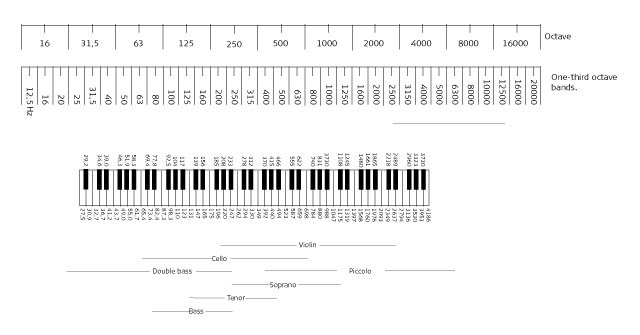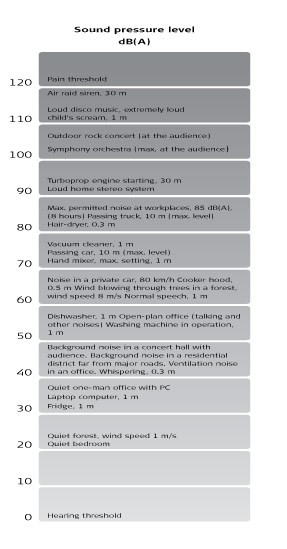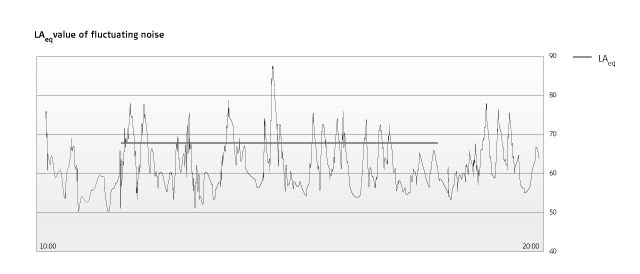Key acoustic terms
Good acoustics in a room are a precondition for a healthy indoor climate. Learn about the most important concepts within room acoustics here!
- Sound is elastic mechanical oscillations in mediums such as the air, liquids or solid materials. Frequency, which is measured in Hertz (Hz), expresses the number of oscillations per second.
- The human ear can register deep sounds from approx. 20 Hz to high sounds of 15,000-18,000 Hz.
- In demanding situations, building acoustics involve sounds ranging from approx. 63 to 8,000 Hz.
- The decibel (dB) is a logarithmic scale which is used to express the intensity of sound. In practice, the scale ranges from 0 dB to 120-130 dB. The latter sound levels can damage the ear.
- By incorporating an A filter, which takes frequency into account, sound can be measured in dB(A), which more clearly expresses how the ear perceives the sound.
- The Leq value expresses the potential health effects and discomfort which may be caused by sound. The upper limit for noise at the workplace is set at 85 dB(A) for eight hours, which corresponds to 88 dB(A) for four hours, 91 dB(A) for two hours and so on.
- The peak value for a single loud sound (such as a shot) is expressed by Lpeak, which must never exceed 137 dB.
The following section introduces the terms and calculation principles which are necessary to calculate sound and the experience of sound in a room. Armed with this basic know-how, it is possible to be aware of and avoid the acoustic pitfalls which can occur in buildings.
Sound is elastic mechanical oscillations in mediums such as the air, liquids or solid materials. All materials are elastic, but this elasticity is greatest in gases and least in solids. Take a bicycle pump, block the air outlet, and pump. The elasticity that you feel is the elasticity in the trapped air.
Figure 1: Spread of a plane sound wave in air:

It is the molecules in the materials which fluctuate, for example when a loudspeaker pushes the air molecules in front of the diaphragm. The resulting oscillatory energy is transferred to the neighbouring molecules, and in this way the sound is transmitted (i.e. the sound energy) to the surroundings. When the energy hits the ear, the eardrum is activated, and we hear the sound if it has an appropriate pitch (frequency) and loudness. (See Figure 1).
Sound oscillations can also be generated in solid substances. If we drill into a wall, sound energy is transmitted to the wall, and the sound can then travel over considerable distances inside the wall. People living in concrete buildings can certainly testify to this.
Figure 2:

Frequency is the number of (sound) oscillations per second. The unit of measurement is hertz (Hz). The human ear is capable of registering frequencies ranging from 20 Hz (very deep bass) up to 15,000-18,000 Hz (very high frequency, treble). As we grow older, our ability to hear the very highest treble tones (for example the sound of a grasshopper) declines, so that at the age of 60 the upper limit is about 10,000 Hz.
In building acoustics, we are usually involved with how building materials behave in the frequency range from approx. 125 Hz to approx. 4,000 Hz. In demanding situations from approx. 63 Hz to approx. 8,000 Hz.
Loudness depends on the amplitude of the sound oscillations. Loudness can be expressed in several ways, but usually you measure how strong the sound pressure is. If you then look at the audio range of the human ear, from weak sound pressure (small oscillations) to strong sound pressure (large oscillations), it can be seen that the ear covers a vast span.
The strongest sound pressure is thus about a million times greater than the weakest sound pressure which can be registered by the human ear. It therefore makes sense to switch to a different scale, the so-called decibel scale. This (logarithmic) scale better matches the way in which the ear perceives variations in sound. The scale is designed so that 0 decibel (dB) corresponds to the weakest sound we can hear. The most powerful sound we can be exposed to on the other hand measures 120-130 dB. The scale below shows typical pressure sound levels, stated in dB.
Noise barometer - 0 dB does not mean that there is no sound present. It just means that we are at the bottom limit of what we, as humans, can hear. There may well be sounds that are weaker than 0 dB – we just cannot register them.
Figure 3: Noise barometer

We also need to add a couple of other terms connected to the sound level which relate to how the character of the sound intensity affects our hearing and how we perceive the sound.
The ear does not register all frequencies equally as strong. In general, deep tones are perceived as being weaker than high tones, i.e. the sensitivity of the ear varies according to audio frequency. When you measure loudness, it is therefore necessary to take this into account in order to obtain a measurement value which corresponds to the way in which we perceive sound.
Figure 4: A-weighting

Sound pressure meters do this by incorporating a so-called A filter, which suppresses low tones in relation to high tones, so that the measured value (roughly) corresponds to the way in which we hear the sound. The measured value is called dB(A), and if we see a noise level indicated as, for example, 65 dB(A), it means that the sound pressure level was measured with a meter where the A filter was activated. By far the majority of measurements must be conducted in this way. There are other weightings, but they are very rarely used. Official noise requirements are (almost) always stated in dB(A).
Most noise impacts to which we are exposed vary over time. Just think about the experience of traffic noise when you are standing beside a road and listening to it. Or the sounds at your workplace, which also vary throughout the day, switching between high and low intensity, breaks etc. The equivalent, continuous sound pressure level, Leq. was introduced to take account of these changing situations. It is a calculation of the average noise level measured over a certain time interval, for example eight hours. The concept was introduced in order to express sound levels that vary over time (for example traffic noise), resulting in a single decibel value which takes into account the total sound energy over the period of time of interest. Fluctuating noise which is measured over a certain time period represents the combined energy.
Figure 5:
 The fact that it is energy which is being compared ties in with the fact that the theories about noise damage and noise nuisance are linked to the noise energy to which you have been exposed. In other words, a strong, brief noise has the same harmful effect as weaker, longer lasting noise. It is not perfect, but at the moment it is the best model available. The Leq concept is inevitably linked to a period of time, as it expresses an energy. Therefore, whenever a Leq value is mentioned, it must be accompanied by a duration, otherwise it is meaningless. The official maximum limit for damaging noise in the workplace is thus:
The fact that it is energy which is being compared ties in with the fact that the theories about noise damage and noise nuisance are linked to the noise energy to which you have been exposed. In other words, a strong, brief noise has the same harmful effect as weaker, longer lasting noise. It is not perfect, but at the moment it is the best model available. The Leq concept is inevitably linked to a period of time, as it expresses an energy. Therefore, whenever a Leq value is mentioned, it must be accompanied by a duration, otherwise it is meaningless. The official maximum limit for damaging noise in the workplace is thus:
“Leq = 85 dB(A) over an eight-hour working day”
The noise dose to which you are exposed therefore corresponds to 88 dB(A) for four hours, 91 dB(A) for two hours, and so on. In all three cases the noise dose is the same.
The reason for including the Leq concept in this review is that it features in all the requirements made the authorities in relation to noise in the workplace (as mentioned above), noise emitted by businesses to the outdoor environment, traffic noise etc. Also, the term is frequently misunderstood, as the fact that it is an average value is often overlooked. Thus, it is certainly possible for short periods of time to have higher noise levels than the Leq value yet to stay within the limit.
When talking about the risk of noise-induced hearing loss, another term is needed – the peak value for sound pressure level. This means the maximum sound pressure level which can occur in a sound sequence. The easiest way of understanding it is in connection with impulse sounds, for example a rifle shot or a drum beat. The peak value is designated as Lpeak, and is also measured in dB.
The Leq value, for example of a shot, taken over even a short period of time, can be very low, as a shot lasts only a few milliseconds. Nevertheless, powerful impulse sounds can cause lasting hearing damage. This indicates that the theory of the equivalent, constant sound pressure level is not bulletproof (apologies!). Sound level meters have therefore been equipped with a so-called impulse of peak display, which registers the absolute maximum value when, for example, you take sound measurements of a shot.
Measurements of impulse noises take place with a sound pressure meter which features this function. The measured value is expressed by Lpeak, for example Lpeak = 127 dB. According to the official limits, the human ear must not be exposed to peak values above 137 dB.

Reverberation and absorption

Different absorber types within room acoustics

An introduction to good acoustics

Speech intelligibility and speech intelligibility goals

